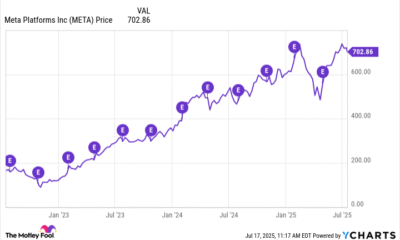Brand Stories
This Artificial Intelligence (AI) Stock Could Hit a $2 Trillion Valuation by 2028

-
Broadcom’s solid growth in the past year has brought the company’s market cap to $1.3 trillion.
-
Its healthy revenue growth, massive addressable market, and improving customer base could help it deliver more upside.
-
Broadcom stock is expensive right now, but it can justify its expensive valuation and will eventually hit a $2 trillion market cap.
Invest in Gold
Broadcom (NASDAQ: AVGO) has become a key player in the artificial intelligence (AI) chip market thanks to its application-specific integrated circuits (ASICs). ASICs are gaining tremendous traction among cloud service providers and hyperscalers because of their cost-effective nature and performance advantages over general-purpose computing chip systems such as graphics cards.
This explains why Broadcom stock has shot up an impressive 65% in the past year, which is significantly higher than the 30% gain for AI chip pioneer Nvidia during this period. This impressive surge has brought Broadcom’s market cap to roughly $1.3 trillion, and it wouldn’t be surprising to see this semiconductor stock enter the $2 trillion market cap club in the next three years.
Let’s look at the reasons why Broadcom seems capable of hitting that milestone by 2028.
Broadcom released its fiscal 2025 second-quarter results (for the three months ended May 4) last month. The chipmaker’s revenue in the first six months of the fiscal year increased by 22% from the year-ago period to $29.9 billion. The impressive growth in sales of the company’s AI chips plays a central role in driving this impressive growth.
Broadcom’s AI chip revenue jumped 77% year over year in the fiscal first quarter, followed by a 46% increase in Q2. The company has sold $8.5 billion worth of AI chips in the first half of the year, which means that it is getting nearly 30% of its top line from this segment. Broadcom expects to sell $5.1 billion worth of AI chips in the current quarter, which would be a 60% jump from the year-ago period.
So, the company is on track to register a healthy jump in AI revenue compared to the previous fiscal year, when it sold $12.2 billion worth of AI chips. Importantly, Broadcom’s AI revenue still has tremendous room for growth, thanks to a couple of factors.
First, the adoption of custom AI processors is increasing at a healthy pace. Major cloud computing companies such as Microsoft, Alphabet‘s Google, Amazon, and AI giants such as OpenAI are turning to custom chips to deliver cutting-edge performance to their customers at reasonable prices. Microsoft, for instance, released two in-house chips late last year to speed up AI workloads and improve the security of its data center infrastructure.
Brand Stories
PR News | Why the Media, Influencers and Brands Flocked to Substack

| Laura Davidson (L) and Dana Curatolo co-authored this article. |
Everyone seems to be launching a newsletter these days. What began a couple of years ago as a wave of respected journalists creating Substack newsletters to connect directly with PR professionals has evolved into something much broader. In 2025, we’re seeing not just media insiders, but also top-tier travel influencers, new tastemakers, luxury hotel brands and even private jet companies leveraging Substack as a direct channel to speak to their audiences.
This surge is more than a trend—it signals a fundamental shift in how brands build community, shape narrative and stay top-of-mind in an increasingly fragmented media landscape.
Substack is no longer a niche media tool. It has emerged as a powerful content platform for curated storytelling, cultural perspective and brand intimacy—especially in the luxury travel space, where experience and emotion drive engagement. According to Business Insider, and with more than 35 million active subscriptions and two million paid, Substack offers unparalleled reach and loyalty. Open rates often triple those of traditional social media platforms, making it a compelling channel for thoughtful, long-form engagement with audiences who want to hear from you.
In the past, luxury travel brands relied almost exclusively on leading traditional print and digital outlets like Condé Nast Traveler, Robb Report and Travel + Leisure to tell their stories. These glossy features still hold immense sway—and we love working with them—but as editorial teams streamline and legacy titles narrow their focus, many PR professionals are looking elsewhere to round out their media mix.
Newsletters like those on Substack offer an elegant solution: a direct-to-inbox format with a highly engaged and often loyal readership. It’s not just about eyeballs—it’s about intent. When someone subscribes to a newsletter, they’re actively choosing to invite that voice into their daily or weekly rhythm. That kind of permission-based content is gold in a world of dwindling attention spans.
Notably, travel journalists and editors are leading the charge. Writers like Yolanda Edwards (a Substack veteran), Sarah Khan, Laura Itzkowitz and more—are carving out spaces to share deeper, more personal travel commentary—often with greater freedom and editorial richness than traditional outlets allow. Whether they’re writing about under-the-radar design hotels in Italy or reflecting on the future of luxury hospitality, the tone is thoughtful, refined and often more honest than a glossy spread permits.
It’s not just journalists. Influential voices in fashion, design, hospitality and culture are also finding new creative freedom on the platform. Claudia Williams writes about style and aesthetics in a way that interweaves her global travel experiences and with a sensibility that resonates with culinary insiders and brand marketers alike.
And the brands themselves are catching on. Luxury hotels, airlines, cruise lines and private travel providers are beginning to use the platform either directly or through collaborations to deepen connections with their most discerning guests. Where once a property might have relied solely on third-party media validation, today they’re commissioning bespoke newsletter content, partnering with newsletter authors on immersive press trips, or even quietly launching branded newsletters of their own—disguised as editorial-first platforms.
Substack newsletters are uniquely effective at driving not just awareness but meaningful engagement. Unlike the often-broad appeal of a magazine feature, a well-crafted newsletter post can prompt direct action—whether it’s bookings, inquiries, or being shared within trusted circles. With a tone that’s more personal and authentic, newsletters resonate with today’s luxury consumers who engage with content selectively, thoughtfully and on their own terms.
So, where is this all going?
What’s next for this space is an exciting evolution of platform diversity and community-first storytelling. We’re seeing new players like The Window Seat by Tori Simokov emerge—blending highly curated travel content with authentic cultural perspective and an editorial voice that resonates with a younger, experience-driven luxury traveler. Tori, a seasoned creative and travel strategist, launched The Window Seat as a Substack dedicated to exploring travel through the lens of storytelling, design and discovery.
We recently hosted her at Park Hyatt New York to experience the new Petrossian tasting experience—an elevated, caviar-forward concept for both guests and locals. The resulting coverage was elegant and personal. It translated to increased awareness and conversation around the initiative among a smaller but highly engaged collective of affluent New Yorkers and global tastemakers passing through the city. The power of that post wasn’t in reach, but in relevance.
This is the kind of storytelling PR professionals should be paying attention to. It’s not about replacing traditional media—it’s about expanding the toolkit. Substack isn’t just another platform to pitch. It’s a space to build relationships, invest in voices that align with your brand’s values and experiment with new formats and collaborations that feel distinctly modern.
What’s especially notable is that these newsletters are being read by the exact audience luxury travel brands want to reach: curious, discerning, culturally plugged-in readers who value quality over quantity. And in many cases, they’re being forwarded, shared and discussed far beyond their initial inbox delivery.
For brands, this presents an opportunity to think more holistically about media strategy. Rather than chasing shrinking column inches or vying for viral moments on social, why not invest in depth, trust and intentionality? Partnering with newsletter authors—whether through experiences, collaborations, or content swaps—can yield long-tail results that extend well beyond a single feature.
In an era where consumers are increasingly skeptical of advertising and overwhelmed by content, newsletters represent a refreshing return to slow media. And in the luxury travel space, where trust, aspiration and emotional connection are everything, that’s an opportunity too powerful to ignore.
***
Laura Davidson is CEO and Founder of LDPR. Dana Curatolo is Senior Vice President at LDPR.
Brand Stories
How Olive Group of Hotels Is Redefining Wellness Travel in India—And Why the World Is Watching
Olive Group of Hotels is setting new standards in wellness travel across India, gaining worldwide recognition for their innovative and holistic guest experiences.

Wellness travel is transforming from a luxury niche into a global necessity. Across continents, today’s travelers—especially health-conscious millennials and Gen Z—are redefining what it means to stay well on the road. At the forefront of this movement stands the Olive Group of Hotels, an India-based hospitality leader blending modern living with a deep commitment to holistic wellness.
A Wellness Wave, Not a Fad
Global wellness tourism is now an $800 billion industry, propelled by growing awareness around mental health, burnout, and the need for balance in daily life. Post-pandemic, travelers seek more than just comfort; they want experiences that enhance well-being and foster personal growth. Olive Group’s strategy directly responds to this demand, offering an ecosystem where physical, mental, and emotional health are prioritized.
The Olive Model: Where Hospitality Meets Well-Being
Unlike traditional hotels that treat wellness as an add-on, Olive integrates it into every aspect of the guest journey. Extended-stay suites come equipped with kitchenettes, enabling guests to maintain healthy eating habits. Rooms are designed with natural light, air purification, and ergonomic workspaces—elements proven to reduce fatigue and boost focus.
Guests enjoy access to in-room fitness kits, meditation corners, and digital wellness tools, making self-care part of the daily routine. Olive’s F&B menus highlight nutritious, locally sourced ingredients, with options for plant-based, gluten-free, and detox-focused diets. This seamless integration ensures that wellness isn’t a feature—it’s the foundation.
Personalization Through Technology and Human Touch
What truly sets Olive apart is its embrace of deep personalization. Guests can tailor their stays with app-based wellness programs, book virtual consultations with nutritionists or yoga instructors, and even set custom lighting or sleep settings from their smartphones. The combination of tech-driven convenience and authentic human care creates a guest experience that feels intuitive and empowering.
Urban Oases and Spiritual Gateways
Olive Group’s presence across India’s urban hubs and spiritual destinations amplifies its impact. In cities like Delhi, Hyderabad, and Bengaluru, Olive appeals to business travelers and digital nomads seeking respite from the city’s pace. Meanwhile, in places like Haridwar and Rishikesh, properties are designed to facilitate transformative journeys—connecting guests to yoga, meditation, and local wellness traditions.
Lessons for the Global Hospitality Industry
Olive Group’s evolution signals a new era for hotels worldwide. The future belongs to brands that view wellness not as a spa package, but as a core operating principle. By designing spaces and services around holistic well-being—supported by smart technology and sustainable practices—hotels can build lasting loyalty and set new standards for guest satisfaction.
“Olive’s strategy offers a blueprint for the next generation of hospitality—where wellness is woven into every guest experience, and personalization is powered by both innovation and empathy.” — Industry Analyst, Hospitality Expert
As travelers demand more meaningful, health-focused journeys, the Olive Group of Hotels demonstrates that true hospitality is about helping guests thrive—mind, body, and spirit. In doing so, Olive is not just responding to a trend; it is defining what the future of travel can be.
Disclosure: The author has no direct affiliation with Bloom Hotels, nor does this article include any sponsored content or promotional material. The opinions expressed in this article are based on publicly available information and are intended to provide an objective overview of Bloom Hotels and its services.
Brand Stories
Bloom Hotels: A Modern Vision of Hospitality Redefining Travel
Bloom Hotels represents a modern vision of hospitality, redefining travel for a new generation with innovative design, smart comfort, and memorable stays.

In a rapidly evolving hospitality landscape, Bloom Hotels stands as a testament to the changing preferences of today’s travelers. As modern tourism leans toward personalized, sustainable, and experience-driven stays, Bloom Hotels has successfully navigated the intersection of comfort, innovation and local connection, creating an environment that feels both familiar and forward-thinking.
For those seeking not just a place to stay but an experience that resonates beyond the conventional, Bloom Hotels offers a distinctive solution. Here’s why Bloom Hotels has become a top choice for travelers who value simplicity, sustainability and seamless integration of technology.
A Fresh Take on Modern Hospitality
Bloom Hotels embodies a refreshingly modern approach to hospitality, breaking away from the trappings of traditional luxury without compromising on quality or comfort. Its minimalistic yet functional design speaks to the evolving tastes of today’s traveler, who values efficiency and thoughtful aesthetics. Each location, while adhering to the Bloom Hotels brand’s consistent ethos, integrates elements that reflect its environment, creating spaces that feel grounded yet innovative.
Rooms are designed to provide both functionality and relaxation offering features like ergonomic beds, ample workspace and high-speed internet connectivity. Guests are greeted with a streamlined experience that prioritizes ease and accessibility, from swift check-ins to intuitive in-room technology. It’s not about excess, but about providing what’s necessary for a comfortable, efficient stay.
The Power of Personalization
Millennials and Gen Z have rewritten the rules of modern travel, prioritizing personal growth and experience over traditional luxury. Bloom Hotels has recognized this shift and catered to these evolving demands by offering highly personalized experiences that go beyond the ordinary.
Guests can curate their own experiences, from choosing the type of room that best suits their needs to customizing in-house services. Whether it’s a wellness-focused retreat or a city break with a local cultural immersion, Bloom Hotels provides a range of options that reflect the diverse needs of today’s travelers.
For business travelers, the hotel’s seamless integration of technology allows for swift, efficient stays, with features like digital check-ins, 24/7 support, and flexible workspace arrangements. Leisure guests, on the other hand, can explore local recommendations curated by the hotel’s expert staff, enhancing the connection to the destination.
Sustainable and Thoughtful Operations
In a time when sustainability is no longer a luxury but a necessity, Bloom Hotels has committed to reducing its environmental footprint. The brand’s approach to sustainability is both practical and impactful. From energy-efficient lighting and water conservation measures to the use of locally sourced materials and eco-friendly cleaning products, every aspect of Bloom Hotels’ operations reflects its dedication to minimizing environmental impact.
Bloom Hotels also places a significant focus on the local community, integrating regional elements into the guest experience and ensuring that tourism benefits the areas it serves. By partnering with local artisans, sourcing produce from nearby markets, and supporting regional causes, Bloom Hotels creates a sustainable ecosystem that supports both travelers and the local community.
Technology That Enhances, Not Distracts
The modern traveler demands convenience and personalization, and Bloom Hotels meets these expectations with cutting-edge technology. Yet, unlike many hotel chains that overcomplicate guest services with excessive tech, Bloom Hotels takes a measured approach, using technology to enhance the guest experience without overwhelming it.
The hotel’s mobile app allows for easy booking, check-in, and room customization, while in-room technology provides guests with control over lighting, temperature, and entertainment options. By integrating technology in a way that is intuitive and user-friendly, Bloom Hotels enables guests to focus on what truly matters whether that’s work, relaxation or exploration.
Local Connection with a Global Reach
Bloom Hotels thrives on its ability to offer guests a local experience without sacrificing international standards. Whether you’re in the heart of a bustling city or a more tranquil setting, Bloom Hotels ensures that each location captures the essence of its surroundings.
By offering curated local experiences, from guided tours to culinary experiences, Bloom Hotels gives travelers an authentic connection to the region while maintaining the high standards of service they expect. It’s this blend of global consistency and local flavor that sets Bloom Hotels apart in a crowded hospitality market.
The Future of Hospitality
As we look ahead to 2025 and beyond, the expectations of the modern traveler continue to evolve. Bloom Hotels is well-positioned to meet these demands, offering a seamless blend of comfort, innovation and sustainability. For travelers who value simplicity, authenticity, and thoughtful design, Bloom Hotels represents a new standard in the hospitality industry a hotel experience that is both grounded and forward-thinking.
In an era where travelers are seeking not just luxury but authenticity and deeper connections, Bloom Hotels offers a compelling model for how hospitality can evolve to meet the changing needs of a new generation of global citizens.
Disclosure: The author has no direct affiliation with Bloom Hotels, nor does this article include any sponsored content or promotional material. The opinions expressed in this article are based on publicly available information and are intended to provide an objective overview of Bloom Hotels and its services.
-

 Brand Stories7 hours ago
Brand Stories7 hours agoBloom Hotels: A Modern Vision of Hospitality Redefining Travel
-

 Brand Stories7 hours ago
Brand Stories7 hours agoHow Olive Group of Hotels Is Redefining Wellness Travel in India—And Why the World Is Watching
-

 Destinations & Things To Do1 day ago
Destinations & Things To Do1 day agoUntouched Destinations: Stunning Hidden Gems You Must Visit
-

 AI in Travel1 day ago
AI in Travel1 day agoAI Travel Revolution: Must-Have Guide to the Best Experience
-

 Brand Stories1 week ago
Brand Stories1 week agoHow Elon Musk’s rogue Grok chatbot became a cautionary AI tale
-

 Brand Stories2 weeks ago
Brand Stories2 weeks agoVoice AI Startup ElevenLabs Plans to Add Hubs Around the World
-

 Asia Travel Pulse2 weeks ago
Asia Travel Pulse2 weeks agoLooking For Adventure In Asia? Here Are 7 Epic Destinations You Need To Experience At Least Once – Zee News
-

 AI in Travel2 weeks ago
AI in Travel2 weeks ago‘Will AI take my job?’ A trip to a Beijing fortune-telling bar to see what lies ahead | China
-

 Brand Stories2 weeks ago
Brand Stories2 weeks agoChatGPT — the last of the great romantics
-

 The Travel Revolution of Our Era1 month ago
The Travel Revolution of Our Era1 month agoCheQin.ai Redefines Hotel Booking with Zero-Commission Model






